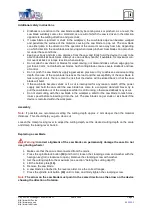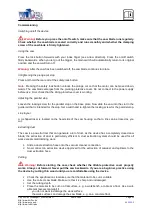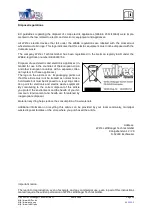
Connect the saw to the power supply.
Hold the device firmly and place its metal base plate on the surface to be cut. Make sure that
the rear half of the base plate protrudes beyond the work surface. Do not pierce the saw blade
into the material.
Switch on the saw and wait a moment until the saw blade has reached the highest speed.
Then press the safety lock button and press the saw blade slowly and gently, but still firmly,
into the material. Then slide the tool forward along the line to be cut.
Note:
Never pull the saw backwards!
The tool should be guided along the cut with very little force. Too much force will cause the
operator to become tired and the saw blade and saw itself to be excessively worn. Exerting
too much force can also lead to the temperature protection being activated, which leads to
delays in the operating sequence.
Make sure that the base plate always lies flat on the material to be cut. This is especially im-
portant at the beginning and at the end of a cut and whenever thin strips are cut that do not
fully support the base plate.
When you have finished cutting and before switching the saw off, lift it off the work surface. If
there is a lot of dust, leave the saw switched on for a few more seconds so that the remaining
dust can be extracted from the interior of the device.
Plunge cutting
Plunge cutting may not be possible with some hard materials.
Select a suitable saw blade for hard materials and insert it. Unplug the power cord, set the cut-
ting depth, and then place the metal base plate on the work surface. Make sure that the front
marking on the base plate is on the starting line.
Switch on the saw and wait a moment until the saw blade has reached the highest speed.
Next, dip the saw blade slowly and gently, yet firmly, into the material. Then slide the saw for -
ward along the line to be cut.
Note:
Never pull the saw backwards!
When reaching finish line, lift the saw off the work surface before turning it off. If there is a lot
of dust, leave the saw switched on for a few more seconds so that the remaining dust can be
sucked out of the inside of the device.
Tips for plunge cutting
If the cut is to be covered, e. g. by a ventilation cover, the corners can overlap; this will ensure
that the cut-off parts are completely detached.
If the cut-out can be seen, the corners must not overlap. In these circumstances, since the
saw blade is circular, the cut-off parts will not be completely detached. The corners must
therefore be reworked with a knife. If the material is thin and the back is unimportant, the cut-
off parts can simply be pushed out.
If you can get to the back of the material to be cut, the cut-out can be made slightly larger from
behind. The cut is then done from the back to ensure perfect corners on the front.
Cutting particularly hard or rough material
Before you saw something harder, learn how to use the saw by using it on soft wood. When
cutting harder material, e. g. hardwood, more force is required to hold the workpiece, and you
may need to clamp it.
Never cut materials that set free toxic dust or fumes such as asbestos.
Cutting ceramic tiles, slate, etc.
Only use a saw blade specially developed for this purpose.
Always use a suitable vacuum cleaner or a connected dust extraction system, as the dust can
be dangerous for the operator and prevents the protective device from properly working.
© by WilTec Wildanger Technik GmbH
Item 62554
Page 11
http://www.WilTec.de
http://www.aoyue.eu
04 2021
-1













